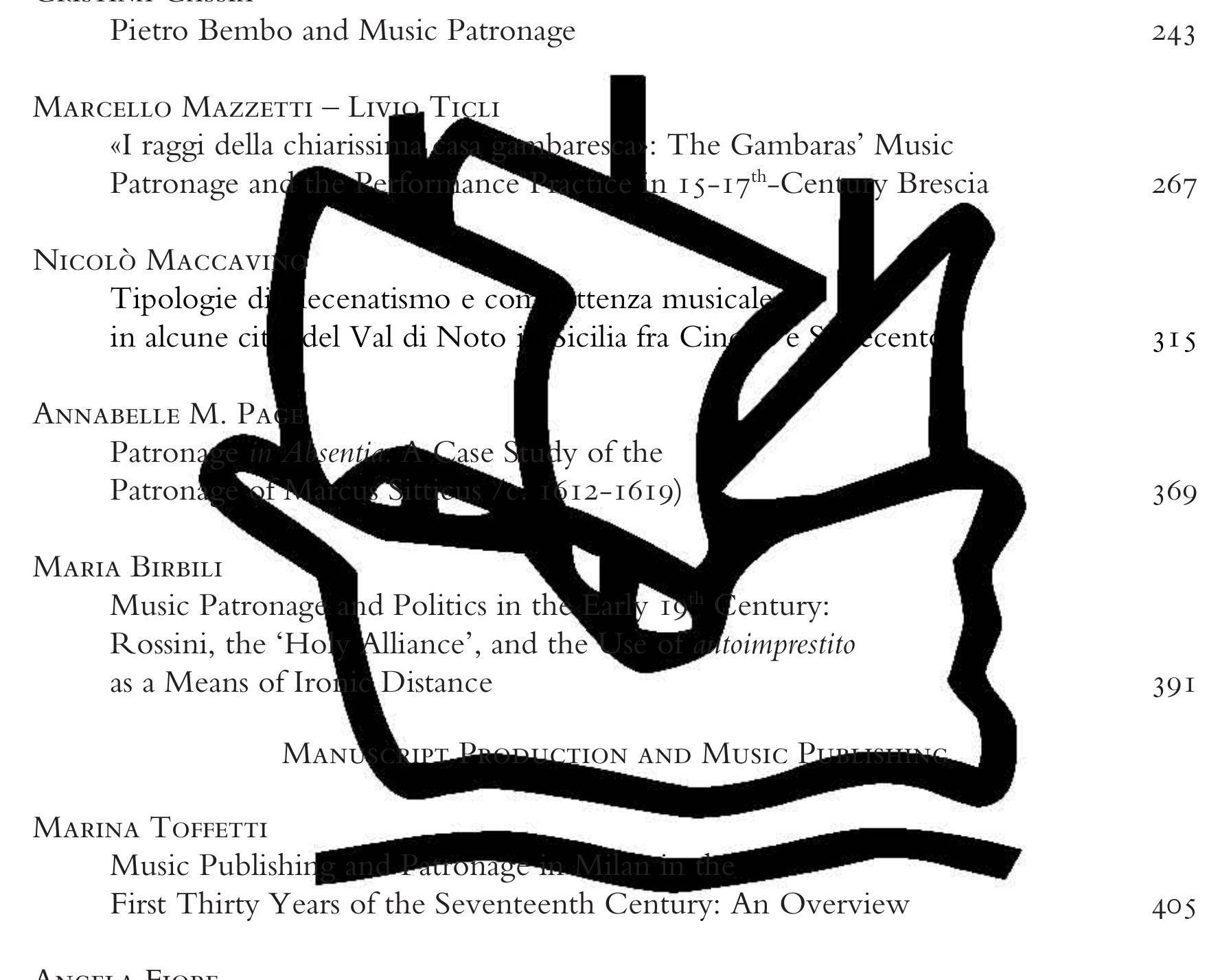«I raggi della chiarissima casa gambaresca». The Gambaras’ Music Patronage and the Performance Practice in 15th-17th-century Brescia (original) (raw)
2021, Music Patronage in Italy, edited by Galliano Ciliberti, Brepols
Abstract
Mazzetti, Marcello, and Livio Ticli. ‘«I Raggi Della Chiarissima Casa Gambaresca». The Gambaras’ Music Patronage and the Performance Practice in 15th-17th-Century Brescia’. In Music Patronage in Italy, edited by Galliano Ciliberti, 267–314. Studies on Italian Music History 15. Turnhout: Brepols, 2021. ABSTRACT. Although for the last three decades music historiography has been reconsidering the role of Brescia within a broader musical landscape, there is still a lack of scholarship on noble patronage within Terraferma’s territories devoid of courts. In a city like Brescia, where a strong aristocracy built up a complex web between religious and civic institutions, the role of music as an instrument of assertion of power should not be underestimated. The chapter will focus on some members of the patrizio-veneto branch of the Gambara family who surrounded themselves with musical goods à la mode – increasing their instrument and book collections – and with a great number of musicians, who were appointed as family tutors and/or composers of sacred and secular works dedicated to the family. In this complex web, important names for the history of keyboard music come to light such as Fiorenzo Maschera, Costanzo Antegnati and Claudio Merulo. A central role was played by noblewomen of the Maggi and Gambara families choosing and buying instruments, hiring music teachers, organising private challenges and games based on poetry-music-dance synergies. New archival findings show an extended network between Brescia and other important cities across northern Italy. We will discuss the career of the count Francesco Gambara, who developed his musical and artistic preferences in Brescia by hosting at his palace the Accademia dei Rapiti (1590-1598), and in Bologna by attending the Accademia dei Gelati. These connections shed light on the genesis of important musical works by Banchieri and Bottrigari which Francesco Gambara directly patronised. The Gambara family is also an excellent case study for investigating how the patronage influenced ecclesiastic institutions such as Santa Maria delle Grazie in Brescia and its music chapel. Thanks to the cardinal Uberto Gambara, the San Girolamo congregation from Fiesole settled in Santa Maria delle Grazie at the beginning of the sixteenth century. The importance of this religious order in Brescia becomes clear if we consider that Pietro Lappi worked there as a kapellmeister and, benefitting from Gambara sponsorship for over thirty years, he could hire some of the most famous musicians of his time such as Cesario Gussago, Giovani Francesco Capello and Giovani Battista Fontana. Lastly, we will explore the reflection of Gambara patronage on music genres and forms strictly related to Brescia (canzona da sonare and canzonetta) by considering some works of Brescian Canons Regulars Floriano Canale and Giovanni Paolo Caprioli. BOOK ABSTRACT. During the Renaissance and throughout the Baroque and Classical periods, musical production is linked to patronage. There are essentially two types of patronage. The first relates to political institutions, to public life, and aims to promote musical events that highlight the wealth and power of the patron in the eyes of rival courts and subjects – hence the birth of the court chapels. The second type belongs to the private sphere, in which the patron, of noble birth and as such in possession of high moral and intellectual virtues, possesses a discriminating artistic sensibility — hence the promotion of chamber music activities, the collecting of rare and valuable musical instruments, and the compilation and collection of musical manuscripts, possibly in deluxe or personalized copies. This musical production system, as described, lasted until the middle of the nineteenth century, when the advent of capitalism and the rise of the bourgeois class caused the decline of patronage. This book focuses on the various aspects of music patronage in Italy from the fifteenth to the eighteenth century. The papers collected here deal with musical patronage and its relations with contemporary society from different points of view, offering new reserch perspectives.
Figures (8)
[
Ex. 1: O passi sparsi, Sebastiano Festa (reduction of lower parts), RISM B/1 1526° and Giovanni Pacalon (lute intabulation), D-Mbs, Mus ms. 266, bb. 1-14. This letter was signed in Padua on 1* November by Giovanni Pacalone, a neglected igure except for lutenists**. His name appears amongst the composers included in the Mus. ns. 266 from the Bayerische Staatsbibliothek in Munich, a miscellaneous manuscript of [87 lute pieces, mostly in Italian intabulation. We find an attribution to «Zua Pacalono» *s that is, the intabulation of a four-voice piece by Sebastiano Festa, who 86 n O passi sparst et to music the Pertrarch’s sonnet that echoes the first ode of Horace*’. Dealing with a nusical setting such as this — which represents an intermediate source between the text (in his case Festa’s madrigal) and the performance — Pacalone (as well as any instrumentalist) sould have made his artistic choices according to two criteria: creating an intavolatura for nstrument(s) only, or a version for both voice and instrument, so as to preserve the textual ispect as well. Both possibilities represent a sounding-interpretation of the poetic text and in intertextual allusion, which connects potentially all compositional models, both the nusical and poetical ones. TO SF Og ED mcs PN me ew wii ees mee aed
Key takeaways
AI
- The Gambara family's patronage significantly shaped Brescia's music culture from the 15th to 17th centuries.
- Noblewomen organized music events and influenced instrument selection, reinforcing their cultural power.
- Francesco Gambara's connections with Accademia dei Rapiti and Bologna shaped significant musical works.
- Archival discoveries reveal an extensive network linking Brescia with northern Italian cities.
- Patronage dynamics shifted from public to private spheres by the mid-19th century, affecting music production.

Loading Preview
Sorry, preview is currently unavailable. You can download the paper by clicking the button above.






